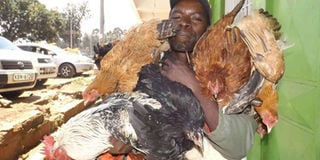Diary of a Poultry Farmer: Strange chicken disease giving me sleepless nights

A chicken trader sells kienyeji chicken in Ol Kalou. PHOTO | JOHN GITHINJI | NATION MEDIA GROUP
What you need to know:
- Deep down, I suspected I was dealing with more than the effects of cold weather.
- I have also come to learn that even the best trained professionals sometimes give conflicting advice.
- Fowl pox was the last diagnosis on my mind because, from my reading, it affects much older birds and vaccination against this disease is not due until week six.
- I must say this disease is causing me sleepless nights, yet there is no help in sight.
On August 1, I received this text message from Cleophas, my farm manager.
“I have isolated eight chicks out of the 320 in room six upstairs. The symptoms include watery discharge from the eyes, pimples on the combs, wattle and eyelids, but the appetite is ok.”
“Have you informed the vet,” I enquired. Indeed, he had and the vet attributed the problem to cold weather and advised we move the chicks aged five weeks from the upper room to the lower one, which is warmer.
Deep down, I suspected I was dealing with more than the effects of cold weather.
I started reflecting on the emails I receive from readers seeking my advice on many issues relating to poultry farming. In particular, farmers describe symptoms of their sick birds and ask what to do.
Being on the periphery of agricultural sciences, I always refer them to animal experts even when I think the symptoms they are dealing with mimic a condition I have dealt with.
I have always resisted temptation to proffer solutions to appear knowledgeable and helpful. Overtime, this policy has served me well.
No doubt, it is a good thing to consult the experts. However, I have also come to learn that even the best trained professionals sometimes give conflicting advice.
When in doubt, I always seek second or third opinion.
Now, to understand why sometimes you need to trust your intuitions, even as you seek a second opinion, please read further.
INFECTION SPREADING
Two days later on August 3, I received another message from Cleophas indicating that the infection was spreading to other chicks and 15 had died.
At this point, I asked him to seek a second opinion. Like most farmers, the only option available was at the nearby agrovet.
After an hour, I received a text message from Cleophas indicating that the agrovet operator, a vet technician, wished to speak to me directly.
When I called back, she said, “From the symptoms, you are dealing with fowl pox.” Of course this contradicted the advice I had received days before when the problem was linked to the cold weather.
Fowl pox was the last diagnosis on my mind because, from my reading, it affects much older birds and vaccination against this disease is not due until week six.
I was also sure I was not dealing with Gumboro because I had administered vaccines at Day 10 and 18.
Was I dealing with Newcastle Disease? Probably.
From my consultations, although I had followed up the IBD with the first Newcastle vaccine at day 21, booster injections are required to provide maximum protective immunity against it.
I learnt that fowl pox is a slow-spreading disease of fowl and turkeys caused by the avian pox virus and is characterised by blisters on the head and neck.
Most birds recover but a few succumb. There is no known treatment and timely vaccination offers the best protection.
ISOLATE THE INFECTED BIRDS
When I referred back to the Indigenous Chicken Vaccination Programme from Kalro, I realised the schedule for vaccinating against fowl pox prescribed two options: at six weeks, or in hot spot areas, much earlier, at three weeks.” Could my one week delay have caused this havoc?
Now this was my dilemma, “To vaccinate, or not to vaccinate against fowl pox now that a diagnosis had been made.”
When I enquired further, I was sternly warned, “Do not vaccinate sick birds,” she told me.
Instead, the agrovet operator advised to isolate the few birds showing symptoms and administer a five-day course of an antibiotic known as Tylosin.
I followed her instructions, although, when I was penning this piece on August 21, the death toll had reached 136 out of the initial stock of 320 chicks (43 per cent death rate) within a period of three weeks.
(Read also: Know the vaccines for various types of chicks)
Fowl pox vaccine, I learnt, should be administered by a skilled worker only through an injection called a ‘wing stab’. For now, I can’t even vaccinate my healthy birds against fowl pox because every day, about 10 are showing signs of the disease.
What I still find confusing is that another vet thinks I could be dealing with infectious coryza, which can develop into a condition called Chronic Respiratory Disease that had attacked the older birds a few weeks before.
What frightens me the most is this advice from yet another expert: “Depopulate the entire stock of 200 laying hens, and 600 chicks by culling; then clean and disinfect the house and equipment and leave the premises uninhibited for two months before starting all over again.”
This action means temporarily killing the business and starting from scratch. I am still not convinced.
I must say this disease is causing me sleepless nights, yet there is no help in sight. My hope is now on a vet who said he will be available in a week's time.





